Michael Foudy specialises in a dying craft. Right into the small hours during wintertime, the quiet man carefully and deliberately weaves willow branches by hand. Baskets, flower pots and the likes – whatever takes his fancy that week. A muffled radio beside him soon becomes a faraway distraction to the measured task at hand.
“Your mind would go off completely, on weaving or whatever,” the 66-year-old says. “Since I retired, then I’ve had more time on my hands, making them away in the winter.”
At his house in the small village of Ruan, Co Clare, he keeps little secret of his hobby. Hand baskets dotted around, weaved ornaments hanging on the walls and a small hanging basket holds some leaves with an ornamental robin perched atop. In his garden, a bike leans up against the house, baskets front and back with bright red, pink and purple flowers protruding; and a freestanding willow trellis spirals high among the foliage, ready to support sweat peas when the time comes.
“My father used to make baskets, so I’d have watched him up along and I’d have made some a good number a years ago,” he tells The Irish Times. “Later on then, I suppose – you see time is going so fast – we’ll say 30 years ago, I made a few more, getting more experienced on it.”
‘There are times I regret having kids. They’re adults, and it’s now that I’m regretting it, which seems strange’
Cillian Murphy: ‘You had the Kerry babies, the moving statues, no abortion, no divorce. It was like the dark ages’
The Dublin couple who built their house in a week
John Creedon: ‘I was always being sent away, not because they didn’t love me, but because they couldn’t cope’
Born in 1957 (“I’m still very young!”), his is a craft once ubiquitous across Ireland, but now relegated to an ornamental pursuit. Foudy was reared on a farm with eight in the family, where baskets were commonplace, but already the use of the coveted turf basket was dying off.
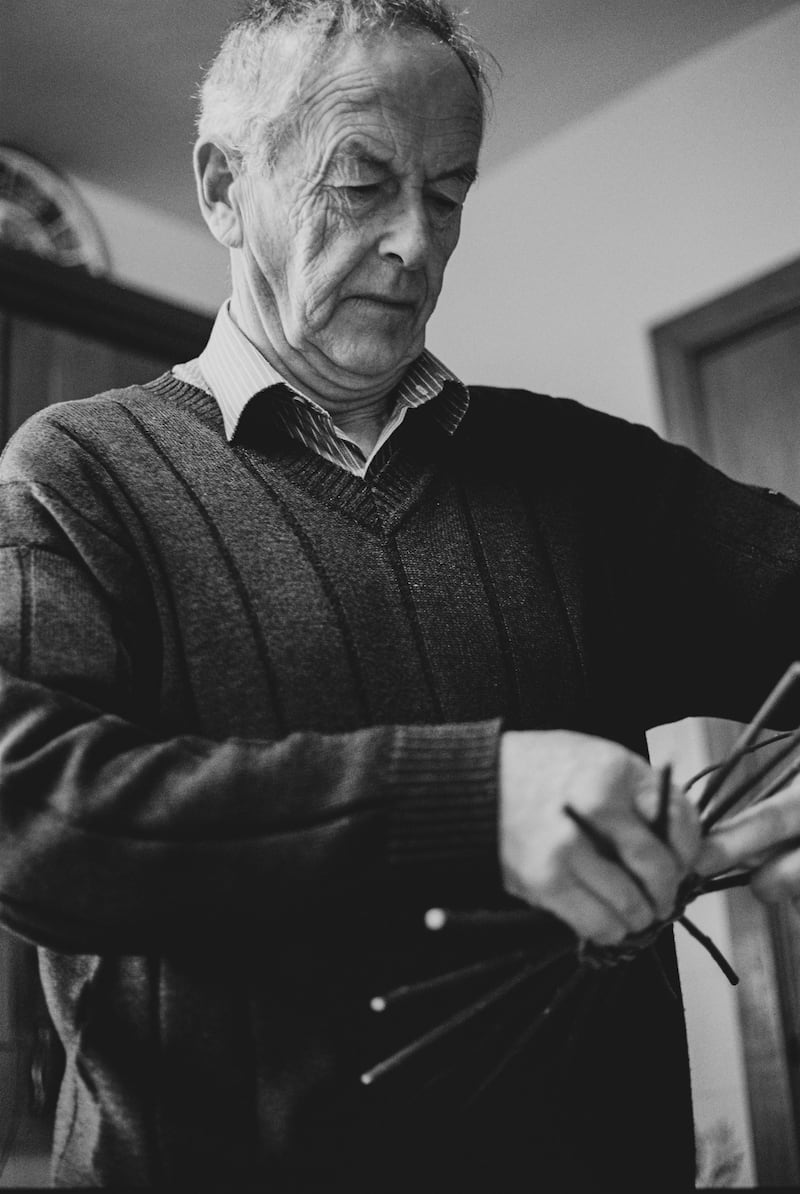
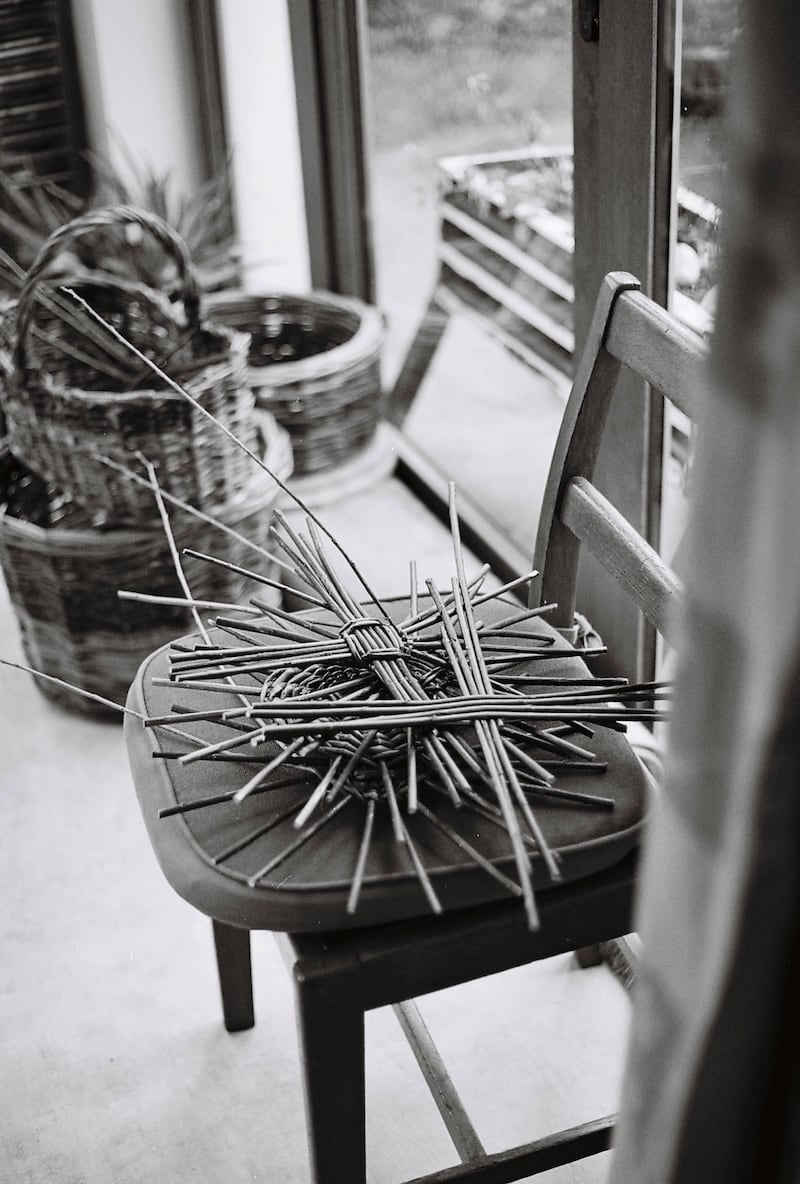
“T’was always involved with my hands,” he says of his career as a linesman for Eircom. “That’d be my line more than a computer we’ll say.”
With natural resources aplenty in Co Clare, Foudy picks wild willows from Inagh and various country lanes in west Clare, taking about 12-14 hours per basket depending on how many handles are needed. All he knows, he learned from his father, the television and the odd book from the library.
“You pick them when the leaves are off at the end of the year, maybe December or January we’d say, before they start to produce their leaves again. You save them for about three months. If you want to, you can keep them to the year after and steep them in water, but usually it’s the fresher ones I use… It’s kind of hard on the fingers, on the hands, you know? You just get them before they go too hard, you know? You’d just have a couple of cutters and a knife – the whole idea is just to give it shape – four or five instruments would do you altogether.
“If you get yourself an old bike, with a basket on and flowers on it – it reminds you of bygone days kind of thing, you know?”
To pass on his skills, he runs basket weaving classes to pass on his knowledge to the next generation.
“You go into the room with a bunch of willows – a couple dozen or whatever – you show the people how to make something with their hands, and they’re really happy when something turns out and they’re walking out the door with the basket.”
Despite the fading prominence of basket weaving in Irish society, with the takeover of factory-made clones long complete, he’s optimistic.
“I think there’ll always be an interest,” he says. “You’ll always find someone that will do the craft. I don’t think it will ever really die away, but I think the baskets are more of an ornament now rather than general use. I think people will still take it on as a hobby for winter – something to do, like. If people had someone to show them how to do it, you’d get a class no problem.”
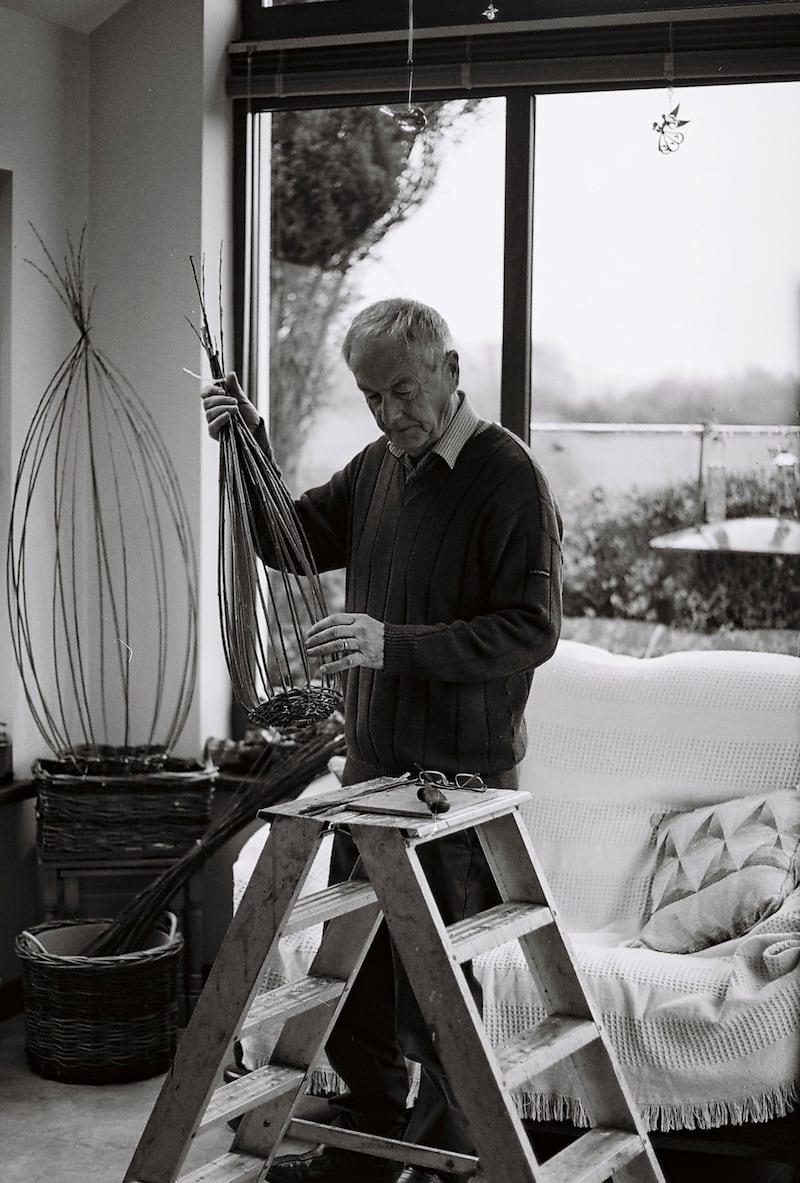
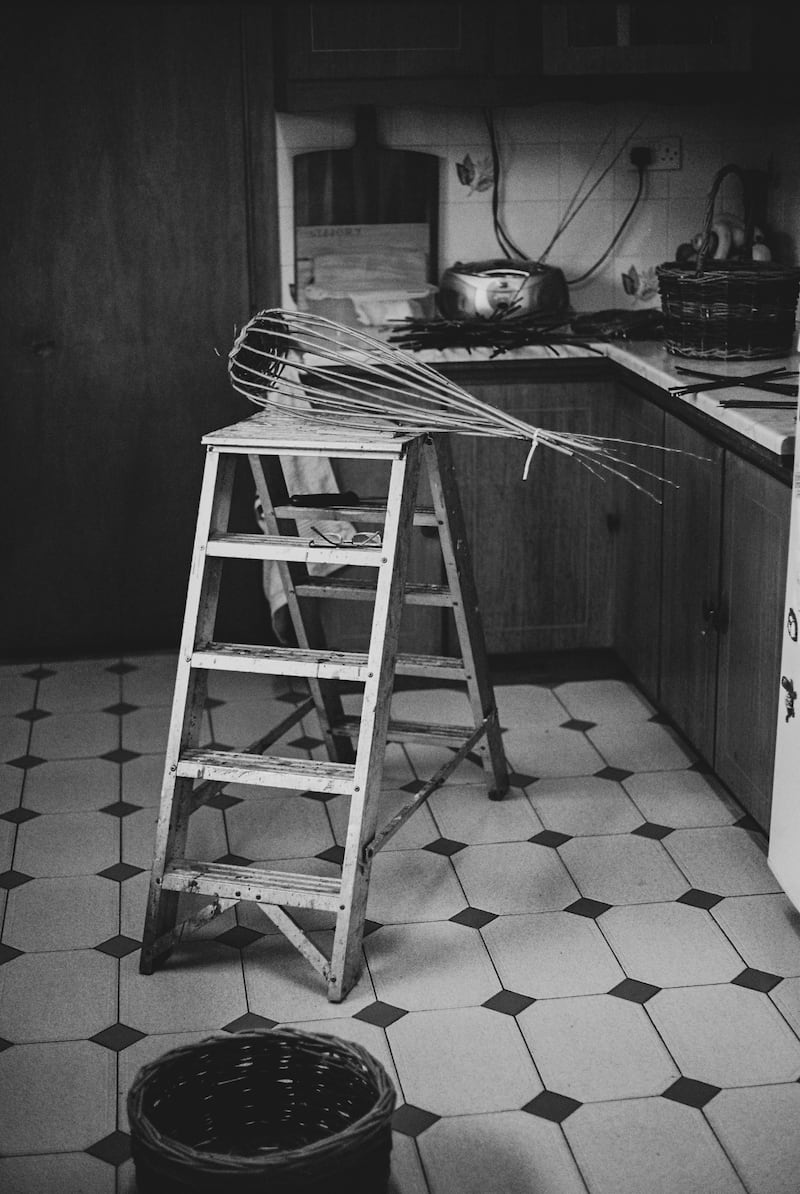
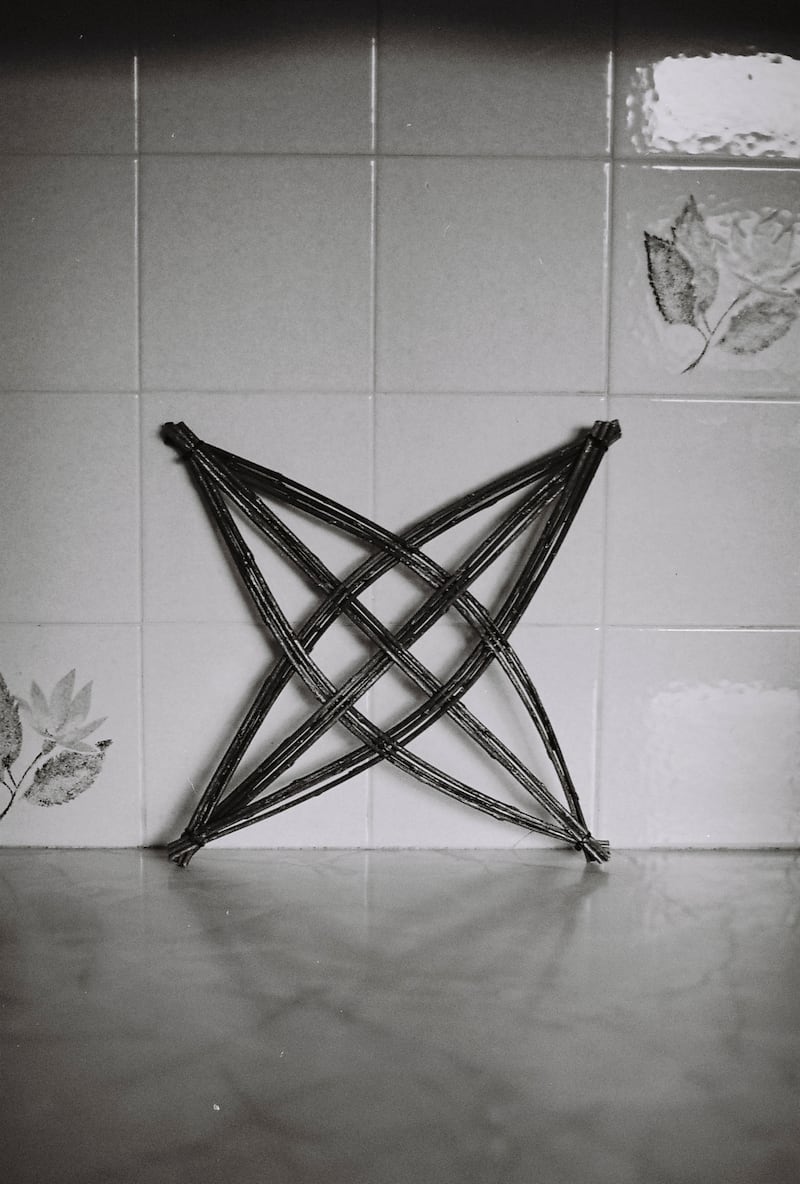
Foudy is part of an upcoming exhibition and festival in the nearby town of Ennistymon next weekend, dedicated to the preservation of traditional and sustainable crafts no longer commonplace in Irish society.
“It’s a festival of lost skills,” says Fionn Kidney, co-founder of Common Knowledge, a non-profit social enterprise. “Really our aim with Rekindle is to celebrate the skills held by older people and to create an opportunity to introduce them to new generations.
“We’ve become disconnected with the world around us in contemporary society. There’s lots that’s been really helpful with technology and advances we’ve made, but often it’s disconnected us from nature and the resources that are all around us.”
The Embers exhibition captures Foudy’s story, and others like him, in an effort to inspire people to think locally and connect with other generations on these crafts which are slowly fading into the history books. Funded by the Arts Council, Clare County Council and the older persons programme with Community Foundation Ireland, Embers tells these stories through a combination of photographs, recorded interviews, oral storytelling, musical performances and live demonstrations, and talks with basket weavers, winterage farmers, apple grafters, farriers, woodturners, sea foragers, oyster catchers, rope makers, Aran knitters, natural dyers and water diviners. Last year’s inaugural festival saw 500 visitors from across Ireland.
“All of these areas are largely connected to nature and the environment around us,” Kidney says. “For us, celebrating these skills is about celebrating older people, but it’s also about celebrating the fact that previous generations were really connected to the world around them in terms of nature and fulfilling their own needs. In today’s world, we often fill our needs by buying in what we need from very far away and paying somebody else to do it.
“Last year [we] brought together a number of musicians who hadn’t played publicly in quite a while, long past their retirement. It was a really magic moment at the festival last year, everyone’s feet were tapping, sean-nós dancing broke out. People loved seeing these older musicians back out, being celebrated and at the centre of the festival. It really added to the atmosphere.”
A little frock maybe if you had the materials. They were hard old times, do you know? You had to make everything
— Josie O’Brien, clothesmaker
Knitting and sewing
Maura Leamy and Josie O’Brien
Longtime friends Maura Leamy and Josie O’Brien get the giggles when they’re together. Although born years apart, the pair are bonded through friendship, place of home and a shared love of their crafts: knitting and sewing. Sewing was once a skill as everyday as riding a bike, and now expert sewers are revered for their craftsmanship.
Born in 1928 in Ballysteen, near the north coast of Co Limerick, O’Brien later married a man in Tulla, Co Clare, where she soon met Leamy, who is nine years her junior. The pair grew up with Singer sewing machines, one operated by foot and the other by hand, and learned the importance of making and darning clothes for six children each in pre-modern Ireland.
Cuimhneamh an Chláir, an independent, voluntary group which digitally records, archives and shares the oral heritage of Co Clare, interviewed Leamy and O’Brien for Embers. The interviews were shared with The Irish Times.
“We were handing down more than anything,” O’Brien tells the Cuimhneamh an Chláir researcher. “If you make something, the next [child] would wear it again. It was like that. You’d knit socks, you’d knit gloves and hats – that kind of thing. A little frock maybe if you had the materials. They were hard old times, do you know? You had to make everything.”
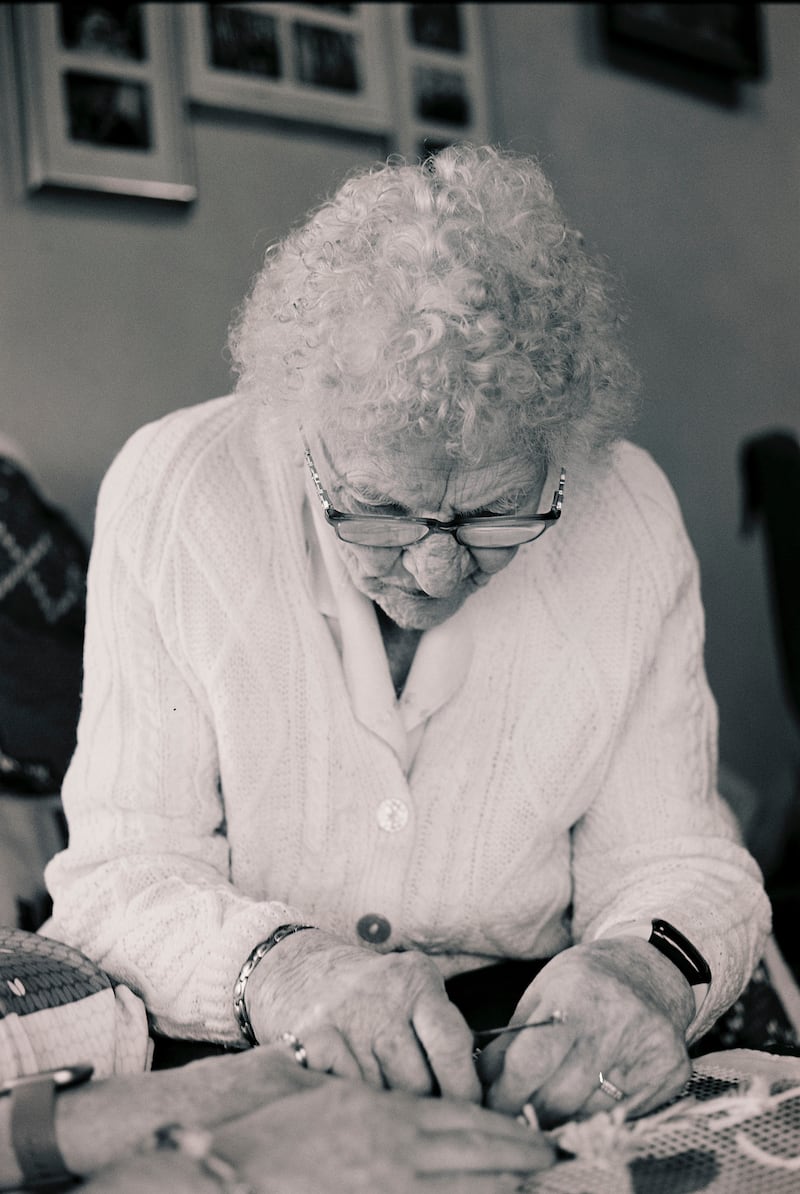
While rearing her children, she spent her evenings making the dinner over an open fire for the family with her mother-in-law who lived into her 90s, and when the children were put to bed she’d knit and sew into the small hours: some legwarmers here, a hat there, maybe even the odd dress. Without manuals lying about, much of the clothing was made just through judging the work by eye.
It is very therapeutic. You just love to perfect those certain stitchings. It’s not a simple thing – you may think it is easy, but it’s not
— Maura Leamy, clothesmaker
Like their mothers before them, O’Brien remembers making bedsheets or even the odd dress from 10st flour sacks: “You’d want to have them coloured and that, like. You’d never want anyone to know they were a flour bag. Everyone was trying to do the best they could.”
She also has an extensive rug collection from over the years, with wool gathered from all parts of the country.
[ Tiers of joy: The Belfast baker elevating cake to an art formOpens in new window ]
“I made one lovely [rug]. T’was navy, and a pink rose in the middle,” she says, then pausing for a beat. “And I put it into the washing machine. I should have put it in a pillow or something, but I put it in as it was and [the colours] all came out. Oh I was raging! And all the hours I had spent to do it.” Even with a frustrating story like that, she cracks an infectious laugh.
One patchwork blanket for a turf basket stands out in her Tulla home: “That was only bits of wool for God’s sake!... It was only old pieces of wool in the drawer that I knitted together. Honest to God, that’s the way it was.”
Leamy sees her own talents as almost average, such was the widespread level of skill in her day. “Everybody had these skills,” she says. “There was one particular lady, she was older than my mother, and is no longer with is, she was extremely good. She did everything out of her head, she didn’t have any pattern to give her instruction how to do it.”
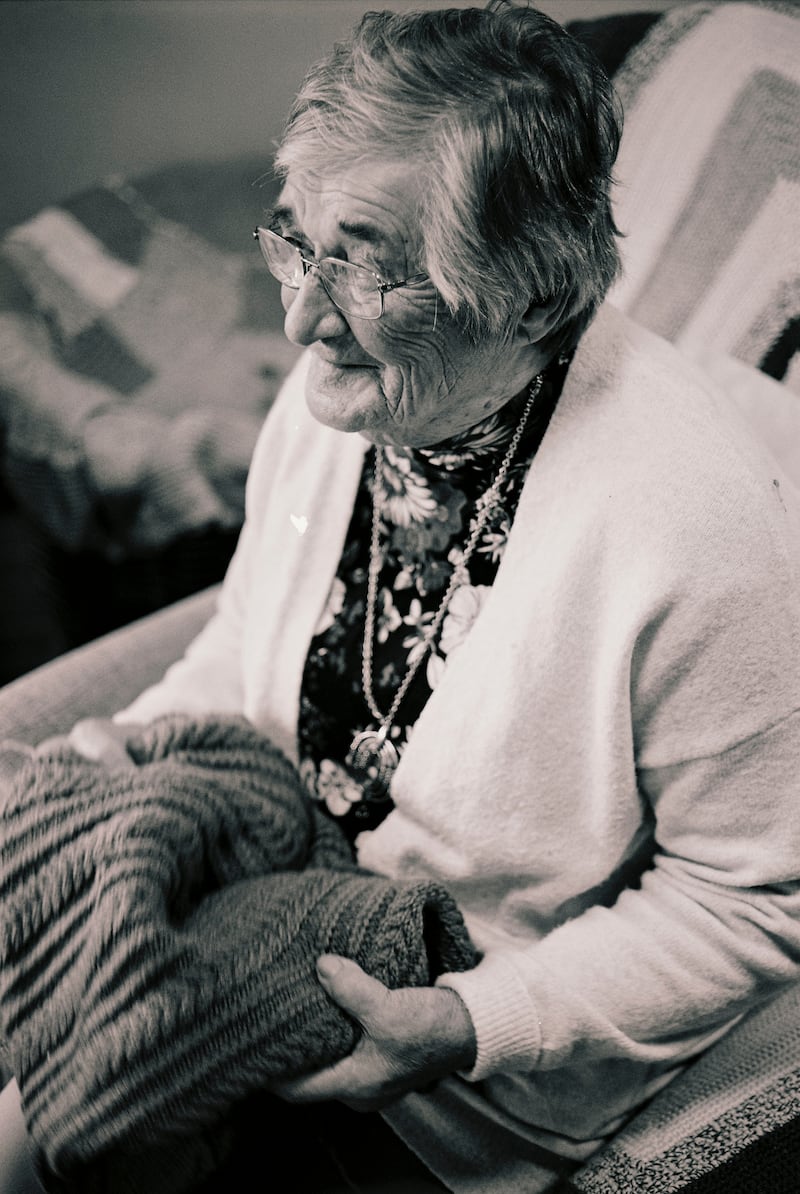
One cherished piece of embroidery on linen, made during a night course when she was 20 years old, still has pride of place in the home, and is only brought out for special occasions for a table. Rose petals, green foliage and red petals are carefully and neatly arranged.
The last time it was taken out was for her parents’ 50th wedding anniversary: “There might be something else happening over the next 10 years, if I’m around,” she says.
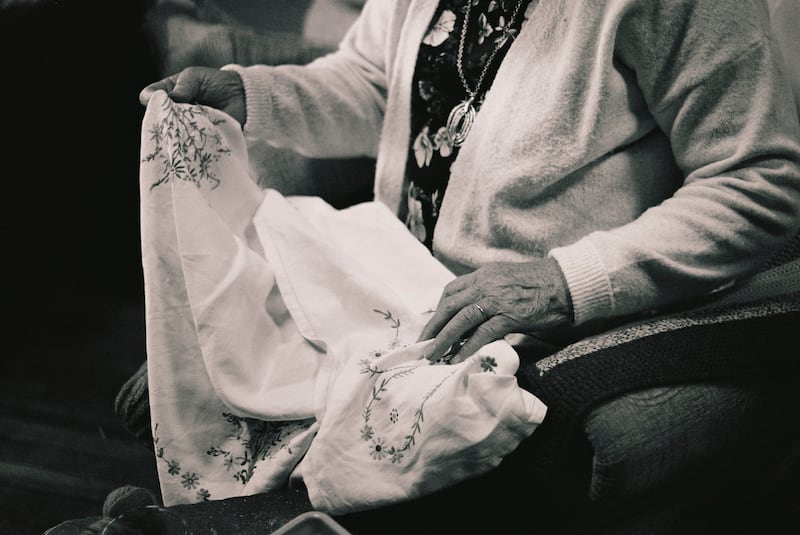
“It is very therapeutic. You just love to perfect those certain stitchings. It’s not a simple thing – you may think it is easy, but it’s not.
“My nine-year-old granddaughter is able to do the knitting. Knitting is going to stay in that house… but the other teenagers, there’s no interest at all. It’s a different thing altogether. The skill is going to die if it isn’t renewed and kept on.”
Apple grafter
Thomas Barry
While retired English teacher Thomas Barry has at least 130 apple trees at his Inagh home, he also has dogs, hens, ducks, two geese (one called Mahatma Gandhi), a donkey named Wilfred, a goat named Mrs White and all manner of plants and insects that call his four-acre garden their home.
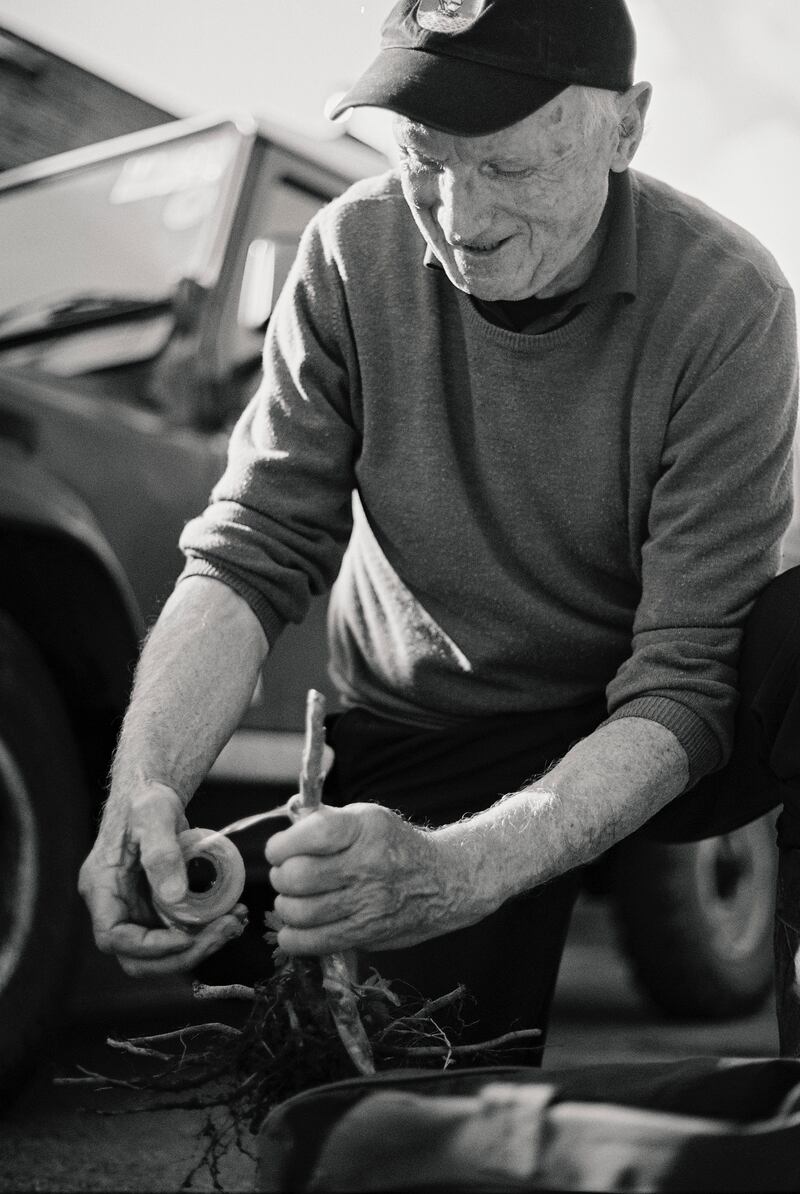
Cuimhneamh an Chláir also interviewed Barry for the Embers exhibition. “Donkeys are inclined to criminality, aren’t ye?” he jokes with Wilfred in the orchard during the hour-long oral history recording, referring to occasional thefts around the apple trees. “To keep the grass in the orchard, you have to have it grazed. If you cut it with strimmers, what grows I find are the weeds… The old people had solutions for every problem.”
His craft? Apple grafting, which involves taking a favoured apple variety and splicing it onto a desirable rootstock to grow a new tree. No doubt few know as many varieties as he does, with his impressive vocabulary full of apple lingo.
“The Blenheim you need to have out by January,” he says in his back yard orchard. “That is the best apple I’ve ever eaten. We used to do the market in Kilrush and take the apples there and my [late] wife [Dorothy], God love her, she loved the market. They used to be queuing up for the Blenheim Orange… I had to resort to hiding them away because she wanted to take them all to the market!” Barry laughs with a nostalgic look in his eye. “It is an outstanding apple.”
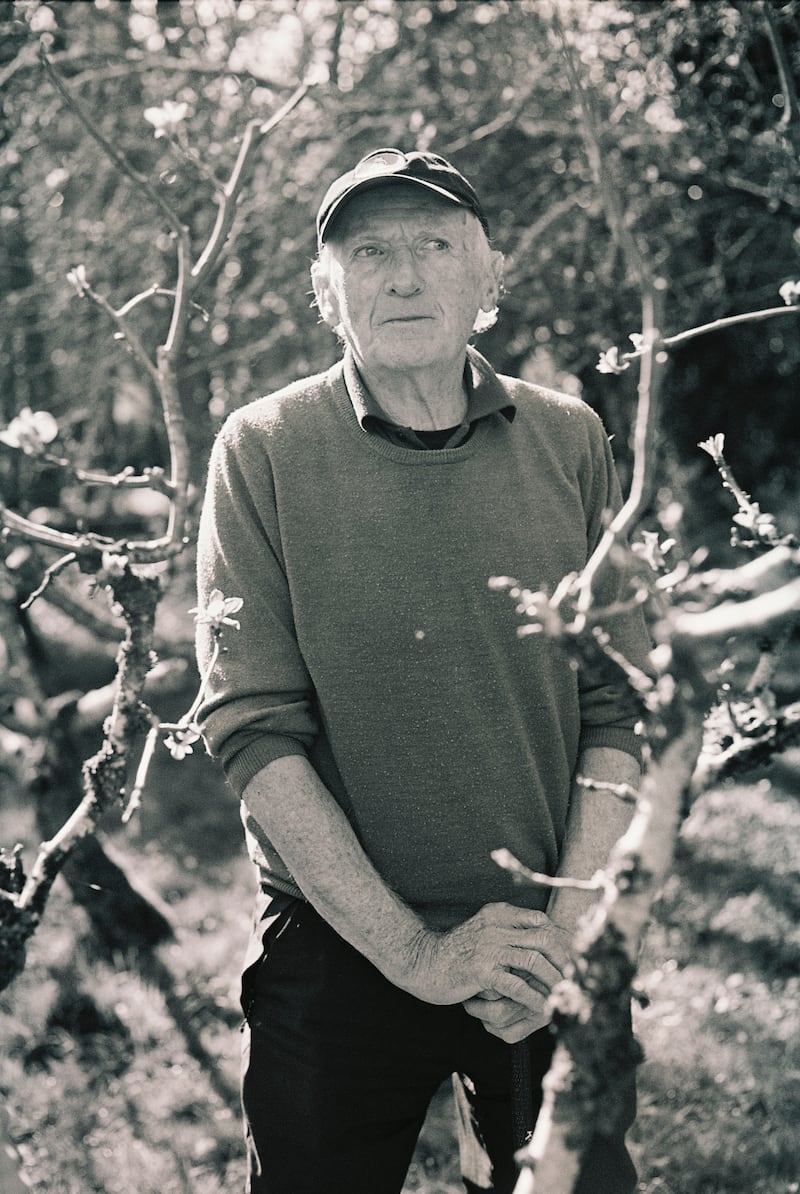
A melodic and well-spoken man, even without prior knowledge of grafting, his grá for the soil beneath his feet and the trees around him is enough to capture attention. For him, the skill of growing and cultivating apples has been lost for some time. He says his parents’ generation didn’t grow apples, but back in the middle of the 18th century it was a different story.
His father was a farmer who left school at the age of 10 but still had the ability to quote Shakespeare spontaneously and accurately. “He had it, he had this love of language,” Barry says, crediting him with his later interest in English.
Barry, a fan of the old ways, has a deep respect for the natural world around him and a keen awareness of environmental damage.
“I loath invasive species or plants that are not native to here,” he says, recalling how an invasive plant previously killed one of his goats. “That’s why I say to people, grow native. I think for the environment, with the Sitka spruce, it’s a disaster [The species is Ireland’s most prominent tree in forestry today, and is originally from North America]. If everywhere [where there are] sitka spruce there were native trees, we’d have massive biodiversity – because underneath those things there’s a desert. What concerns me greatly is that when I was gardening up in those fields in the ‘50s and ‘60s with my neighbour or father, the place was full of insects.” Not any more.
If you leave a piece of land alone, you get trees growing there but they’ll self-seed… If we leave enough space, these creatures will come back
— Thomas Barry, apple grafter
“I think, if the lack and destruction of nature above the ground – if it’s that’s going on in the soil – I think we are in real trouble,” he says.
Only recently did he learn the names of Irish insects as béarla [in English], having learned the Irish names in his youth. “Irish is a language that lends itself to farming, the bog.”
He says the birds have slowly disappeared in the area due to the deteriorating quality of the grass: “That grass has been going down for the last 70/80 years. The pollinators [ask]: ‘Where are the wild bees? There were several varieties of wild bees around.’ I don’t see them any more. The lack of creatures is so noticeable. I don’t have to read about climate change, I can see it.”
[ Into the wild: The nature retreats bringing men back to basicsOpens in new window ]
To compensate for the deteriorating bee population, Barry keeps a hive of honeybees for pollination.
“I fear if I didn’t have the hive, I’m certain I wouldn’t have a crop,” he says. “You’d see the odd one, but to me, the wild bees are gone. There is a compound in weedkiller that destroys the bee’s nervous system. And you have what’s knowns as colony collapse disorder: the bee goes out and it doesn’t come back to the hive. I think it is pesticides, lack of habitat and lack of wildflower meadows. Gone.
“We had an old car in the ‘60s, and a summer’s evening we’d come up from Ennis. The windscreen would be covered with moths. No moths now, they’re gone. That should worry people.”
He speaks with deep concern over the loss of habitat for birds such as the corn crake, which up to 100 years ago was found in every parish in Ireland. Now, just a few can be found in coastal spots along Galway, Mayo and Donegal.
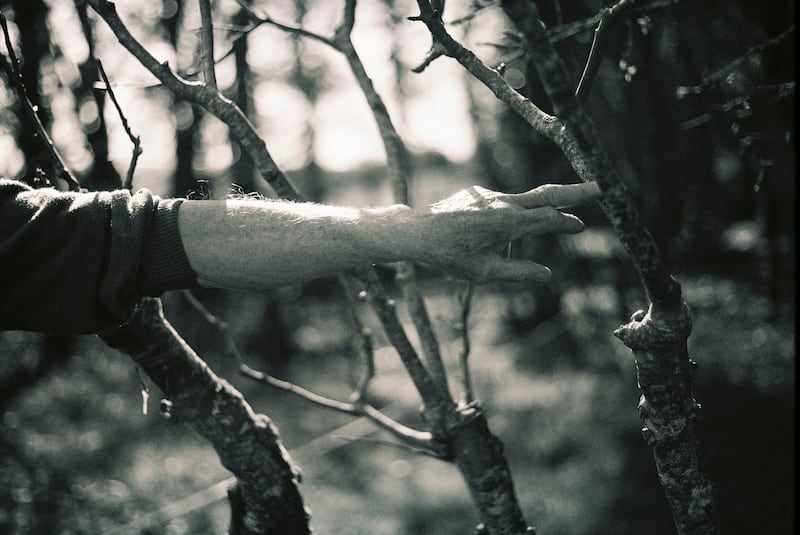
“I do what I can, but it isn’t enough,” he says. “We need to have areas set aside… A lot of land in Ireland is useless. Just leave it alone. If you leave a piece of land alone, you get trees growing there but they’ll self-seed… If we leave enough space, these creatures will come back.”
While Barry puts in the elbow grease at the orchard, it was his late wife who was the master planner, and often spoke of her fears for the environment long before others. He recalls his wife’s rather prescient prediction: “[Insects] are part of the whole system, and when they go, we go. We can’t exist on the planet without them.”
The Embers exhibition is on in Ennistymon, Co Clare from May 12th to 21st, with Rekindle: Festival of Lost Skills on May 14th from noon to 5pm. An opening celebration for Embers is on May 11th, from 6pm to 8.30pm. Tickets are free from tickettailor.com




